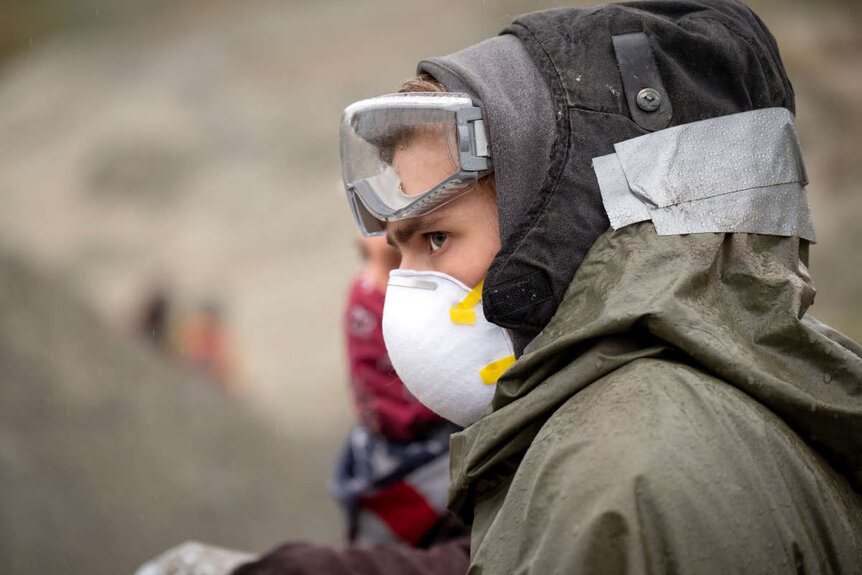Create a free profile to get unlimited access to exclusive videos, sweepstakes, and more!
Why are some people immune to to the pandemic in The Stand or even real-life diseases?

In the late ‘70s, Stephen King set out to write an epic American story to rival The Lord of the Rings. Taking inspiration from news stories involving chemical-biological warfare, King wrote of a ruthlessly lethal flu-like virus and the lucky (or unlucky) few who survive it. The resulting book, The Stand, is King’s longest and one of his most beloved.
The Stand been adapted a few times, first as a miniseries in 1994, then as a comic book in 2008. Currently, CBS All Access is airing a TV version of the classic tome. Every adaptation of The Stand features a wide array of characters, including Mother Abigail and the now-infamous Randall Flagg, all of whom (Flagg excluded) had one central thing in common: they were naturally immune to Captain Trips, the virus which was causing near-total human extinction.
While the events of The Stand are, thankfully, not real, natural immunity to disease is. So, what’s the deal?
Innate Immunity
It’s difficult to know just how many people are naturally immune to which diseases. This is particularly true for diseases that have low transmission or low fatality rates. It also isn’t a static number across diseases, but we do have some data for some of the more well-known diseases — like HIV.
Viruses, being unable to replicate on their own, hijack a host’s cells and turn them into replication machines. They do this by binding to receptors on the surface of cells. Each virus has an array of probes that search for particular receptors they're capable of accessing. This is why different viruses infect different types of cells and result in variable symptoms. A virus might encounter the cells in your nose or throat but pass them by, waiting to find more suitable locales. A cell without the right receptor has nothing to offer a virus.
You can think of the surface of a virus as being covered in keys. In order to infect a specific cell, that cell must have a lock the virus is capable of opening. If a virus enters the body but is unable to unlock a pathway into any of the host’s cells, that’s the end of the game. In fact, there are more viruses living on Earth than there are stars in the observable universe, by a long shot. But most of them don't bother us. They don't have the right keys to our locks. And this is where innate immunity can arise.
We see this in a percentage of the human population in relation to HIV. In order for HIV to infect an individual, it must enter the cells of the immune system via a protein called CCR5. If we wanted to prevent HIV from entering the cells, one way to do it would be to change the proverbial locks via a mutation in CCR5.
Studies in mice with a mutated version of CCR5 have shown an immunity to HIV. Likewise, a mutation of CCR5 exists in approximately 10 percent of Europeans, making them effectively impervious to the disease. Immunity to a deadly disease can feel almost like a superpower, especially when that disease is pervasive and largely unknown, as HIV was in previous decades, or as the novel coronavirus is today.
We typically think of immunity as something that is obtained via exposure, either to a disease in its natural state or through a vaccine. So, how do individuals obtain innate immunity for a disease to which they’ve never been exposed?
Evolutionary Immunity
When it comes to the CCR5 mutation which imbues individuals with immunity to HIV, this one comes down entirely to evolution. Researchers, however, were originally stymied as to a mechanism for an evolutionary change impacting a disease that didn’t exist when the change took place.
It appeared almost as if a subset of the population had adapted in advance to a disease that hadn’t yet emerged. The hypothesized solution involves other diseases that were more frequent in the past and which entered the cells in a similar fashion.
That 10 percent of Europeans who find themselves immune to HIV today, may have centuries-old outbreaks of the Black Death, also known as hemorrhagic fever, to thank.
The idea goes like this: a mutation in CCR5 existed in roughly 1 in 20,000 people several hundred years ago. Continued pressure from hemorrhagic fever caused that mutation to spread across generations of survivors until it accounted for a significant portion of the population, roughly 1 in 10 today.
When HIV emerged, a statistically larger portion of those populations who encountered the Black Death were now equipped to evade a disease which they’d never before encountered, and wouldn't encounter for centuries. In short, natural pressures affected a change in a population which allowed them to better survive a contemporaneous disease, and that effect trickled down into the future.
Since viruses rely on having specific keys capable of opening cellular locks, mutations in those locks can protect individuals from their effects, and from the effects of future diseases that utilize the same processes.
Given the nature of The Stand's Captain Trips — its incredible ubiquity and tenacious lethality — it’s reasonable to assume the few immune survivors are not descendants of a previous adaptation. They must be, instead, the lucky few with a new, relatively recent mutation.
The only good news for a virus like that is that all the remaining population carries whatever mutation is necessary for immunity. That protection would carry on to the next generations with high frequency, protecting them from Captain Trips and, perhaps, from future diseases that rely on the same mechanisms.
Susceptibility to disease is frightening in the best of times, particularly so right now, as we continue through the proverbial wastelands of the current global pandemic. But there’s something comforting about the knowledge that each disease encountered carries with it the possibility of enhanced future protections. And we can thank our lucky stars we have, so far, avoided anything like Captain Trips.
If you haven’t had enough of lethal flu-like viruses, The Stand is streaming now on CBS All Access.



























